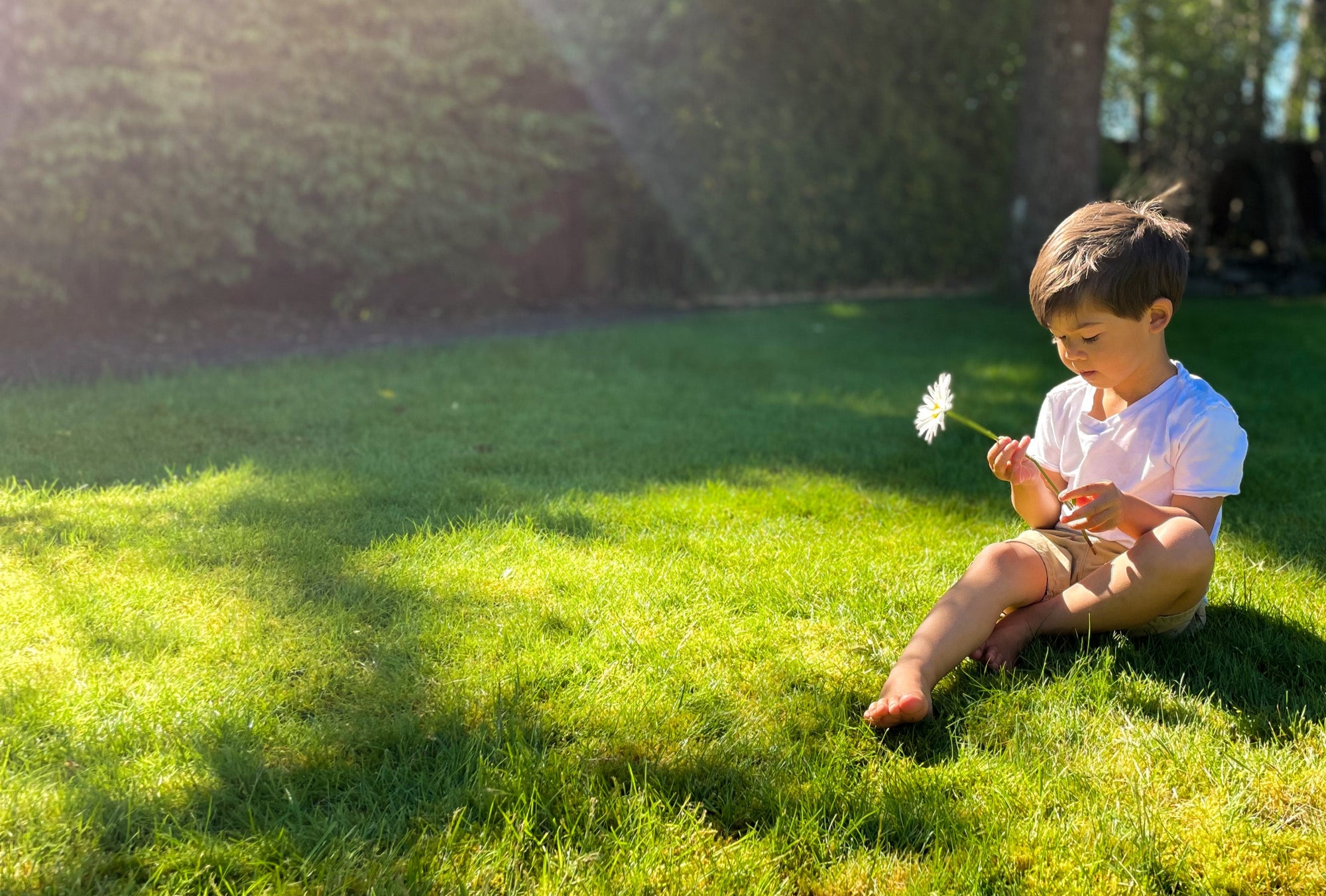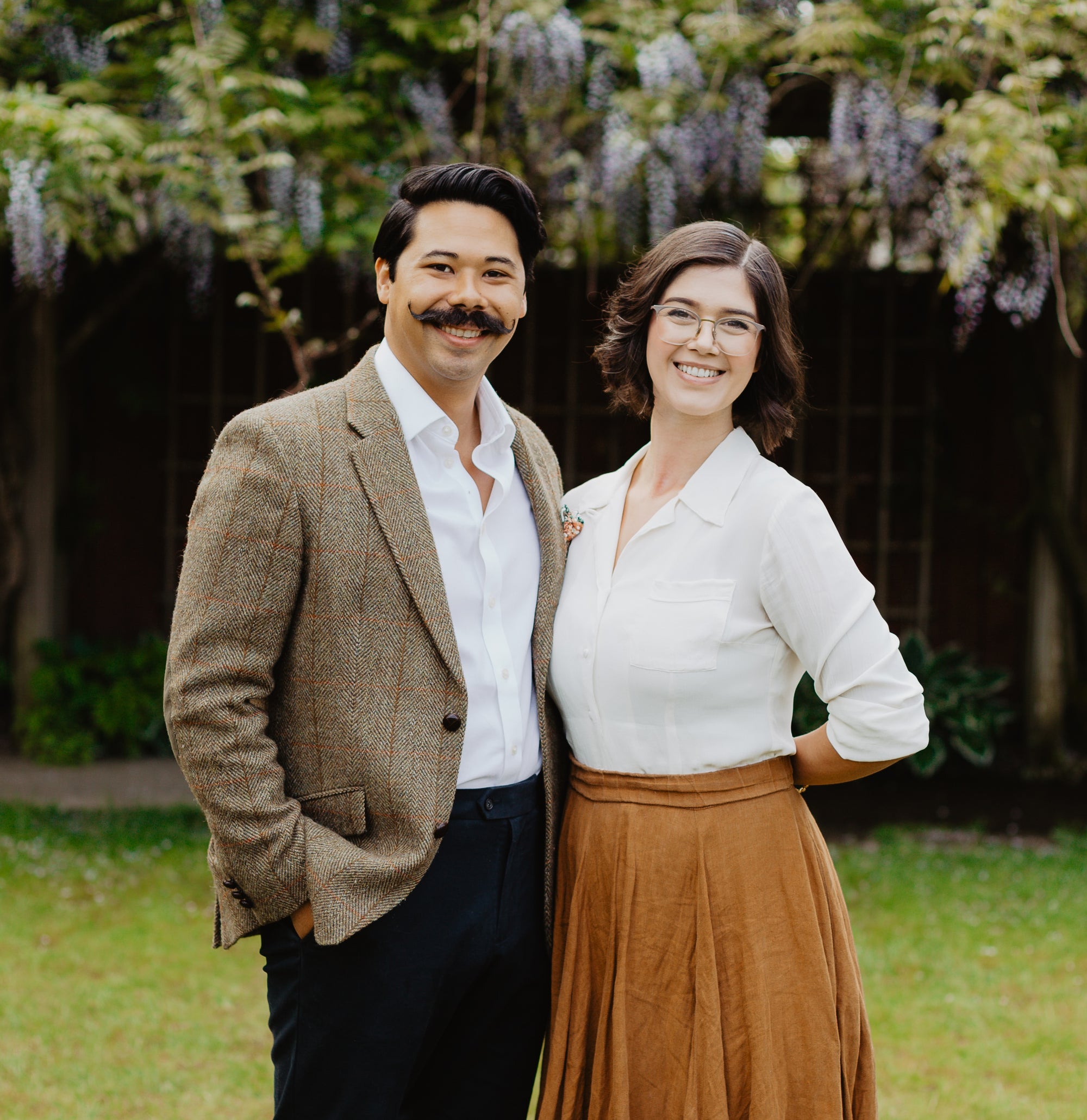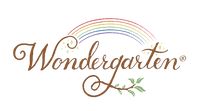OUR
Story & Philosophy
Who we are. What we believe. Where we're going.

summary
Wondergarten was founded in 2022 by Lisa and Nathaniel Santa Cruz as an in-home preschool. After quickly gaining popularity online, they began developing a non-academic, seasonally focused, early childhood curriculum, which they published in 2024. Today, Wondergarten® is a global brand offering more than just curriculum—it opens the door to a rich new world of stories, songs, and illustrations, beautifully crafted homeschool books, supplies, and materials, all connected and supported by a vibrant, growing online community. What began as a simple preschool is now helping families around the world to create Good & Beautiful Childhoods.

Lisa & Nathaniel Santa Cruz
Our Founders
Lisa Santa Cruz is creator of the Wondergarten Curriculum—the director, teacher, and designer of the Wondergarten products, services, and materials.
Nathaniel Santa Cruz is the creator of The World of Wondergarten—the author, composer, and illustrator behind all the songs, stories, and artwork featured throughout the Wondergarten Curriculum.
Together, they have developed a beautifully rich and cohesive resource for early childhood education—fully adapted and supported, made accessible to all.
Our Story
By Nathaniel Santa Cruz
In January 2019, Lisa and I welcomed twin boys into our lives, and our world changed forever.
Suddenly, we found ourselves immersed in a sea of information about what it means to be good parents. Everyone had opinions on how to raise our children—how to feed them, dress them, and educate them. It was overwhelming. Both Lisa and I underwent a sort of identity crisis as we embraced our roles as Mommy and Daddy. As time passed, we began to find our natural rhythm, but one question lingered: What about school? This question loomed, as it does for many parents. Choosing how to educate our children becomes a pivotal part of our identity—and theirs. Would we opt for public school, private school, homeschooling, or something else entirely? Shortly after our boys were born, someone casually mentioned, “You guys are pretty artsy. I think you might like Waldorf.”
Waldorf—What is Waldorf? Intrigued, Lisa and I looked it up and almost immediately fell in love. Its emphasis on art as the very means of education resonated deeply with us, but what we loved most was that the entire educational framework was designed around the concepts of goodness, beauty, and truth, values that Lisa and I hold dearly. Inspired, we immersed ourselves. Lisa devoured every Waldorf book she could find while I studied the lectures of Rudolf Steiner and the deeper philosophies underlying Waldorf education. Gradually, our home began to change and we enjoyed every moment of creating a good and beautiful space for children to live, work, and play in.
We intended to enroll our children in the local Tacoma Waldorf school, until devastating news arrived—it was closing. So we decided to homeschool instead. However, as our twin boys began to approach preschool age, Lisa’s mother, Karen, a master educator of over forty years, encouraged us to not just homeschool but to open an in-home preschool so our boys could be a part of a class. At first, we were nervous about the idea of opening our home to new families and children, but, after much thought and prayer, we decided to do it. So Lisa and her mother began their Fundamentals of Early Childhood training at LifeWays North America, where they learned from experienced teachers on how to educate young children. When they came back from training, Lisa and Karen began making plans to open our in-home preschool, which we decided to call Wondergarten.
Meanwhile, I was deeply entrenched in my career as a Cartographer/GIS Analyst, accumulating over a decade of experience across military, corporate, and government positions. I began as a U.S. Marine, later advancing to roles such as Program Manager for Google Maps, and finally serving as the Senior GIS Analyst at Joint Base Lewis-McChord, WA. Yet, as Wondergarten took shape, I felt compelled to leave my career behind to support my wife and children in our new preschool adventure. Initially focused on managing legalities and operations, I soon found myself immersed in writing weekly children's stories based on four gnomes who live in our backyard. Creating characters, composing songs for lessons, and illustrating my stories on classroom chalkboards became a new source of joy and fulfillment in my life.
In the fall of 2022, Wondergarten opened its doors and we began sharing glimpses of our classroom online. Unexpectedly, our content struck a chord and sparked a viral response. Families from around the world were captivated by what we were doing, inspiring many to recreate something similar in their own homes and communities. As interest in our program grew, so did the demand for a Wondergarten curriculum. So Lisa and I got to work.
For three years, Lisa meticulously developed and tested weekly themes, recipes, and lessons; I documented our journey, created and shared content online, and crafted original songs, stories, and illustrations; all while we continued operating our preschool, maintaining our home, raising three young children, and welcoming a fourth along the way. Phew! Somehow, after ALL that work, we managed to pull this together for you to enjoy.
We hope that our work will bring you joy and happiness, rhythm and harmony to your lives, and of course, goodness and beauty to your home and children.
Made with love and care,
Lisa & Nathaniel Santa Cruz
Philosophical Framework
By Nathaniel Santa Cruz
In the following section, we will introduce the philosophical framework behind our early childhood curriculum and how it fits into the entire life of the child. While much of this philosophy has been inspired by the writings of Rudolf Steiner, it has evolved over the years to more closely align to our personal views and values.
Humanity has four parts: heart, soul, mind, and body*. Together, these parts make a whole human being. As we consider the development of our children, we operate under one very simple idea: develop the whole child—their emotional, spiritual, intellectual, and physical well-being, nurturing each part at the right time and in the right season, not neglecting one part for the sake of the other. When the whole child is cultivated, then, like a tree, they will blossom and bear good fruit. We achieve this by providing:
Goodness for the Heart
Beauty for the Soul
Truth for the Mind
Wellness for the Body.
These are the pillars of our human existence, known through the experience of our daily lives. A whole education must develop the whole child.
The heart requires goodness, which is the fruit of virtuous character. It encompasses all the benefits of love, joy, peace, patience, respect, compassion, gratitude, and generosity. Goodness is what our hearts yearn to experience from others; it is how we build and maintain healthy relationships.
The soul requires beauty, which is the experience of heaven on earth—a sense of the divine witnessed in reality. It not only makes life bearable, but worth living. Beauty is where we experience both awe and wonder and are inspired to create a world we long to see and be a part of.
The mind requires truth, which is factual knowledge about reality derived through the careful examination of life. Through the advancement of learning and the continual exercise of our intellect, we are able to understand ourselves and the world we live in, navigate and overcome obstacles, and derive our sense of meaning, purpose, and significance in life.
The body requires wellness, which encompasses all aspects of physical health and well-being, including nutrition, exercise, sleep, and other practices that build vitality and resilience.
Through lived experience, we know that neglecting any aspect of our being—emotional, spiritual, intellectual, or physical—leads to problems. A neglected heart leads to broken relationships; a neglected soul leads to despair; a neglected mind struggles to overcome challenges; and a neglected body leads to disease. Only when our heart experiences the goodness of others can we build deep and meaningful relationships; only when our soul can experience beauty in the world do we find life worth living; only when our minds are knowledgeable and capable of discerning truth can we navigate the world and solve problems with both confidence and clarity; and only when our body is well are we free to live, move, and breathe.
When all four parts are developed and working together, we will see a truly capable, firmly grounded individual who is ready and able to meet and transform the world—a strong and able body driven by goodness and beauty, guided by truth. This is a picture of human flourishing and what we aim to achieve.
While we must consider the whole child, we must also consider the whole person; not just the 5-year-old in front of us, but also the 35-year-old and the 75-year-old versions of them, too. Considering each of them brings clarity to what is truly most important for their overall well-being—not just for their childhood, but for their entire lives. We should not be asking: What would make them most successful?
Instead, we should ask: What could I give the child that the adult would be grateful for? What would the senior cherish as a memory? Think of your own childhood and recall what you desired more of, or wish your parents had done differently. This is your opportunity; this is their childhood. Make it good and beautiful by being the source of goodness and beauty in their life.
Within our framework, there are three distinct seasons of childhood: early, middle, and late childhood (also called adolescence). Each period spans approximately seven years divided by physiological changes in the body: From birth to the change of teeth, around age seven; from the change of teeth to puberty, around age fourteen; and from puberty to early adulthood, around age twenty-one, when the prefrontal cortex reaches full maturity. In each of these three seasons, we focus on one aspect of the developing child, focusing first on nurturing their heart with goodness during early childhood, their soul with beauty during middle childhood, and their mind with truth during adolescence, all while fostering wellness in their body across all three seasons.
For this reason, we refer to each season as:
The Age of Goodness: Early Childhood (Ages 0-7)
The Age of Beauty: Middle Childhood (Ages 7-14)
The Age of Truth: Adolescence (Ages 14-21)
“Study without desire spoils the memory, and it retains nothing that it takes in.”
— Leonardo Da Vinci
Understanding and respecting these natural seasons of growth ensures that we are planting seeds at the right time, nurturing a love for learning that will last for their entire life. Children will naturally gravitate toward learning when it aligns with their developmental stage and personal interests. When they begin to show a genuine desire for knowledge by asking questions, that is when we know the season is right and they are ready to learn.
The Age of Goodness: Early Childhood (Ages 0-7)
During the early years, children learn best through play, exploration, and imitation. Their hearts are open, and they yearn for love, security, and connection. This is why we focus on nurturing their hearts with goodness. Creating a loving and secure environment in which they feel valued and connected will lay the foundation for all future learning.
The Age of Beauty: Middle Childhood (Ages 7-14)
As children grow, their interests and curiosities begin to expand. In middle childhood, their creativity blossoms, and they start to seek and appreciate beauty in the world around them. This is the time when children begin to create with their hands. Their souls begin to find a voice through art, music, and dance, while gaining inspiration from sources beyond the home as found in history and literature. This is the time to fill their souls with beauty, as learning shifts from imitation to inspiration.
The Age of Truth: Late Childhood (Ages 14-21)
Finally, as they enter adolescence, their minds become ready for truth and yearn for deeper understanding, meaning, and significance. They begin to ask serious questions, seeking knowledge about the world and their purpose in it. This is the time we provide them with tools for discerning truth, solving problems, and thinking independently to prepare them for the challenges of adulthood. This is when inspiration gives birth to innovation.
Our Guiding Principles
by Nathaniel Santa Cruz
In the following section, we will review our guiding principles for working with young children. Many of these insights have been developed and refined through personal experience as both parents and educators, and they reflect a number of deeply held values and convictions that guide and shape all the work we do.
"What sort of plan you have is neither here nor there. What matters is what sort of person you are." — Rudolf Steiner.
This is both an empowering and frightening realization. Think about it—your child will imitate everything you do and say—the good and the bad. They amplify our strengths and reflect our weaknesses. So, what do we hope our children will become? What qualities do we want them to possess? If we desire our children to have certain virtues, it begins with us embodying those virtues first. Simply being is the best way to teach our children; the hard part is consistently modeling the kind of behavior and language that is worthy of their imitation.
If we envision our children as loving, respectful, and grateful individuals, then we must demonstrate these qualities in our daily conduct. If we aspire for them to embrace reading, learning, and the arts, then we need to exemplify a passion for reading, learning, and the arts. Viewing parenting through this lens, instruction through modeling, is the best way to teach our children.
During early childhood, this is the primary mode of education—imitation. So it does not matter if you execute this curriculum perfectly, what matters is who you are in the presence of your children. Our children absorb and reflect our attitudes and behaviors. Let us then see this as an opportunity for personal growth, because when we become better, our children become better too.
As parents, we are the guardians of our children. During early childhood, we believe children ought to be protected from exposure to the dark, violent, and ugly things of the world (a burden they are not equipped to bear). If our children are to flourish, their world must be a safe, predictable, and nourishing place to live. If we immerse ourselves in the joys of their childhood, we can more easily protect their innocence and provide a sanctuary where their needs are met, their voices are heard, and they are allowed to freely explore, create, imagine, and move at their own natural pace.
“Children who live in an atmosphere of love and warmth, and who have around them truly good examples to imitate, are living in their proper element.” — Rudolf Steiner.
The Kingdom of Childhood is a sacred time. If we desire to see our children flourish, then their environment must be like a good and beautiful garden—a wonder garden—where they are free to grow and blossom in the sunshine. We believe that the children who are raised in goodness and beauty will become the adults who will make the world both good and beautiful.
Why then, would we pull them out of this garden? It would be like exposing a tender seedling to the harshness of winter. No, as guardians, we must protect the Kingdom of Childhood so our children will have a strong foundation for the rest of their lives. Rather than bringing them into our adult world, let's immerse ourselves into their world; and in the process, rediscover our own inner-child.
"The soul is healed by being with children." — Fyodor Dostoevsky
Every time our children ask us to play with them, it is an invitation back to this forgotten kingdom. We encourage you to accept the invitation. Put aside your worries (and your phones) and enter the Kingdom of Childhood. Join your children upon the green grass, dance with fairies, work alongside gnomes, and see the world anew through their eyes.
“The small child has fantasy and this is what we must engage... He sees in each thing a being like himself. He sees the stone as having a soul, he personifies everything around him. This faculty of the child is his greatest treasure, the source of all later cognition.” — Rudolf Steiner.
To children, everything in the world is alive. The birds and the bees talk to each other, the sun and moon have thoughts and feelings, flowers can see, and trees breathe. The world is vibrant and animated, and we must embrace this perspective. There is often pressure to dismiss our child’s fantasy and replace it with factual knowledge about the world, believing it gives them a better grounding in reality, but this approach can actually stifle their imagination, which is the bedrock of all creativity and innovation. Telling a child, "That is not real" is the quickest way to deprive their sense of wonder and inhibit their creative spirit.
“The secret of genius is to carry the spirit of the child into old age, which means never losing your enthusiasm.” — Aldous Huxley.
Imaginative children become innovative adults; and innovative adults will change the world. Our future depends on the fantasy of young children.
Our Vision & Purpose
Everything we create—from our songs, stories, books, and illustrations, to every product in our store—is dedicated to educating the whole child, their heart, soul, mind, and body, with goodness, beauty, and truth at the right time and in the right season. Imagine if every child was raised with this framework, but more importantly, had the tools and resources to do it—at home.
This is our vision and the reason Wondergarten exists.
